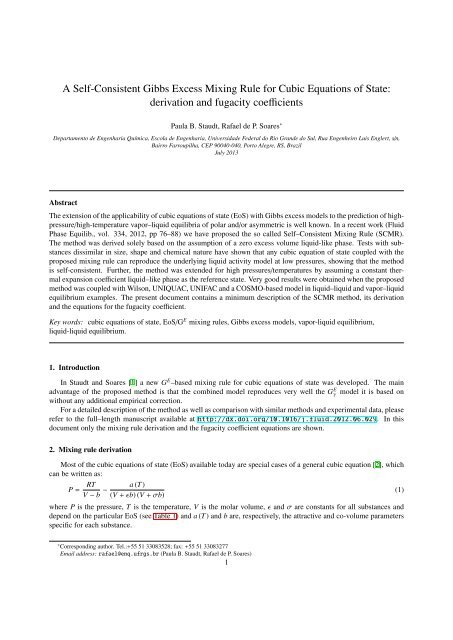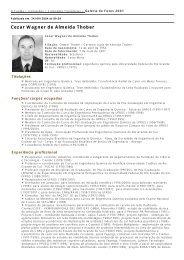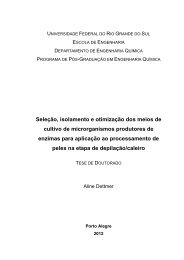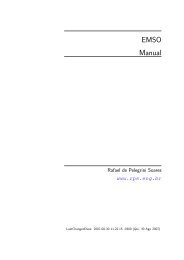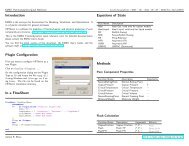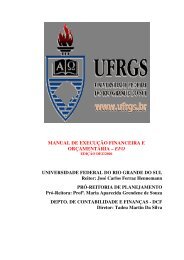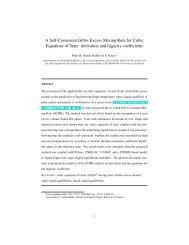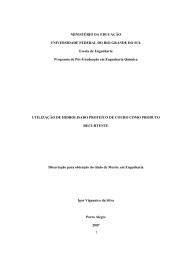derivation and fugacity coefficients - Ufrgs
derivation and fugacity coefficients - Ufrgs
derivation and fugacity coefficients - Ufrgs
- No tags were found...
You also want an ePaper? Increase the reach of your titles
YUMPU automatically turns print PDFs into web optimized ePapers that Google loves.
A Self-Consistent Gibbs Excess Mixing Rule for Cubic Equations of State:<strong>derivation</strong> <strong>and</strong> <strong>fugacity</strong> <strong>coefficients</strong>Paula B. Staudt, Rafael de P. Soares ∗Departamento de Engenharia Química, Escola de Engenharia, Universidade Federal do Rio Gr<strong>and</strong>e do Sul, Rua Engenheiro Luis Englert, s/n,Bairro Farroupilha, CEP 90040-040, Porto Alegre, RS, BrazilJuly 2013AbstractThe extension of the applicability of cubic equations of state (EoS) with Gibbs excess models to the prediction of highpressure/high-temperaturevapor–liquid equilibria of polar <strong>and</strong>/or asymmetric is well known. In a recent work (FluidPhase Equilib., vol. 334, 2012, pp 76–88) we have proposed the so called Self–Consistent Mixing Rule (SCMR).The method was derived solely based on the assumption of a zero excess volume liquid-like phase. Tests with substancesdissimilar in size, shape <strong>and</strong> chemical nature have shown that any cubic equation of state coupled with theproposed mixing rule can reproduce the underlying liquid activity model at low pressures, showing that the methodis self-consistent. Further, the method was extended for high pressures/temperatures by assuming a constant thermalexpansion coefficient liquid–like phase as the reference state. Very good results were obtained when the proposedmethod was coupled with Wilson, UNIQUAC, UNIFAC <strong>and</strong> a COSMO-based model in liquid–liquid <strong>and</strong> vapor–liquidequilibrium examples. The present document contains a minimum description of the SCMR method, its <strong>derivation</strong><strong>and</strong> the equations for the <strong>fugacity</strong> coefficient.Key words: cubic equations of state, EoS/G E mixing rules, Gibbs excess models, vapor-liquid equilibrium,liquid-liquid equilibrium.1. IntroductionIn Staudt <strong>and</strong> Soares [1] a new G E –based mixing rule for cubic equations of state was developed. The mainadvantage of the proposed method is that the combined model reproduces very well the GγE model it is based onwithout any additional empirical correction.For a detailed description of the method as well as comparison with similar methods <strong>and</strong> experimental data, pleaserefer to the full–length manuscript available at http://dx.doi.org/10.1016/j.fluid.2012.06.029. In thisdocument only the mixing rule <strong>derivation</strong> <strong>and</strong> the <strong>fugacity</strong> coefficient equations are shown.2. Mixing rule <strong>derivation</strong>Most of the cubic equations of state (EoS) available today are special cases of a general cubic equation [2], whichcan be written as:P =RTV − b − a (T)(1)(V + ɛb) (V + σb)where P is the pressure, T is the temperature, V is the molar volume, ɛ <strong>and</strong> σ are constants for all substances <strong>and</strong>depend on the particular EoS (see Table 1) <strong>and</strong> a (T) <strong>and</strong> b are, respectively, the attractive <strong>and</strong> co-volume parametersspecific for each substance.∗ Corresponding author. Tel.:+55 51 33083528; fax: +55 51 33083277Email address: rafael@enq.ufrgs.br (Paula B. Staudt, Rafael de P. Soares)1
The attractive a (T) <strong>and</strong> co-volume b parameters are usually determined using generalized correlations based oncritical properties <strong>and</strong> acentric factor, according to:a (T) = Ψ α (T r, ω) R 2 T 2 cP c(2)b = Ω RT cP c(3)where T c is the critical temperature, P c is the critical pressure, ω is the acentric factor, T rtemperature <strong>and</strong> the other symbols are shown in Table 1.= T/T c the reducedTable 1: Specific cubic equation parameters.EoS α(T r ) σ ɛ Ω Ψvan der Waals (vdW) 1 0 0 1/8 27/64Redlich–Kwong (RK) Tr −1/2 1 0 0.08664 0.42748Soave–Redlich–Kwong (SRK) α S RK (T r ; ω) a 1 0 0.08664 0.42748Peng-Robinson (PR) α PR (T r ; ω) b 1 + √ 2 1 − √ 2 0.07780 0.45724α S RK (T r ; ω) = [ 1 + (0.48 + 1.574ω − 0.176ω 2 ) ( 1 − √ )] 2T rb α PR (T r ; ω) = [ 1 + (0.37464 + 1.54226ω − 0.26992ω 2 ) ( 1 − √ T r)] 22.1. Mixing ruleWhen dealing with mixtures, the expressions for the attractive a <strong>and</strong> co-volume b parameters should be computedas a function of the pure substances values a i <strong>and</strong> b i through mixing rules.The van der Waals (vdW) or classic mixing rule, present in most professional process simulation systems, is givenby:a =N∑ √x i x j ai a j (1 − k i j ) (4)i=1b =N∑x i b i (5)i=1where x i is the mole fraction of the substance i <strong>and</strong> k i j is the binary interaction parameter, introduced to improve thecorrelation of phase equilibrium of mixtures.G E –based mixing rules, in contrast to the classic mixing rule, obtain the interaction information from excess Gibbsenergy G E γ models, originally developed for the prediction of liquid activity <strong>coefficients</strong> γ i .One possible expression for computing the Gibbs excess energy from a cubic EoS is [3]:GφE ∑RT = ln φ − x i ln φ i (6)iwhere φ is the mixture <strong>fugacity</strong> coefficient <strong>and</strong> φ i is the <strong>fugacity</strong> coefficient of the pure substance i, all in the sameconditions of temperature <strong>and</strong> pressure.The <strong>fugacity</strong> coefficient considered in Equation 6 for any cubic EoS in the generic form (Equation 1) is given by[4]:ln φ = (Z − 1) − ln(Z − β) + qI (7)where Z ≡ PV/RT is the compressibility factor <strong>and</strong> the other auxiliary variables are: β ≡ Pb/RT, q ≡ a/bRT,I ≡ I 0 ln V+ɛbV+σb , <strong>and</strong> I 0 is a constant given by 1/(σ − ɛ).2
Using Equation 7 one can compute ln φ as well as ln φ i by exchanging the mixture properties (Z, β, q, <strong>and</strong> I) bythe pure substance properties (Z i , β i , q i , <strong>and</strong> I i ). Thus, by combining Equation 6 <strong>and</strong> Equation 7, the Gibbs excessenergy for a cubic EoS can be computed by:GφE ∑RT = (Z − 1) − ln(Z − β) + qI − x i ((Z i − 1) − ln(Z i − β i ) + q i I i ) (8)iiUsing the definition of excess volume V E ≡ V − ∑ i x i V i <strong>and</strong> recalling that ln(Z − β) = ln PRT+ ln(V − b) one canobtain:GφERT = PV E ∑ ( )RT + Vi − b i∑x i ln + qI − x i q i I i (9)V − biThe expression given by Equation 9 contains no simplification assumptions <strong>and</strong> can be used to get a fully consistentmixing rule if we make Gφ E = GE γ . Although exact, the practical use of Equation 9 is limited because it is an implicitmixing rule (the mixture volume V depends on q <strong>and</strong> vice–versa). Now, by assuming that the excess volume isnegligible (V E = 0, V = V Id = ∑ i x i V i ) the following expression is obtained:GφE ∑ ( )RT = Vi − b i∑x i ln + qI Id − xV Id i q i I i (10)− biiwhere b should be computed with the mixing rule Equation 5, the volume of the pure substances V i , as well as I Id <strong>and</strong>I i , should be computed using the liquid-like root of the pure fluids at the system temperature <strong>and</strong> pressure.However, for cubic equations, the attractive parameter a should depend on temperature <strong>and</strong> composition only.Since most G E γ are developed for near–atmospheric pressure, in this work the liquid–like root required for the determinationof V i is obtained at 1 bar. The results would be essentially the same if a zero pressure is taken as reference.Finally, by making G E φ = GE γ a new explicit mixing rule is obtained by isolating q in Equation 10:q = 1 GI⎛⎜⎝E ∑γId RT −i( )Vi − b ix i ln +V Id − b∑x i q i I i⎞⎟⎠ (11)iThe mixing rule given by Equation 11 will reproduce the G E γ model as long as the the system pressure is not toofar from 1 bar <strong>and</strong> the zero excess volume assumption holds. For all tests considered (see the full-length manuscript)the G E φ reproduced the GE γ very well. Thus, the mixing rule given by Equation 11 was referred as the Self–ConsistentMixing Rule (SCMR). The <strong>derivation</strong> of <strong>fugacity</strong> <strong>coefficients</strong> of substances in mixture according to the SCMR isgiven in Section 3.2.2. Extension for high pressure/temperatureIn the mixing rule proposed in the present work, the pure fluid liquid–like volume of each substance in mixtureis necessary. At high temperature conditions, usually above T r ≡ T/T c = 0.7, one can have problems with finding aliquid–like root from the cubic EoS.To circumvent this problem, an alternative procedure is adopted in this work to compute the pure fluid liquid-likemolar volume to be used in Equation 11. From the definition of the volumetric thermal expansion coefficient of a purefluid β i :β i ≡ 1 V i( ∂Vi∂T)P<strong>and</strong> assuming a constant β i , evaluated at a reference temperature Ti ◦ , the molar volume of a pure substance can beobtained by the following expression:(12)ln V iV ◦ i= β i (T − T ◦ i ) (13)3
The pure fluid thermal expansion β i , according to an EoS, is easily determined by its definition (Equation 12).In this work, the reference temperature Ti◦ chosen was that to correspond to a T i,r = 0.5. This temperature corresponds,approximately, to the normal boiling temperature. This reference temperature assures a valid liquid–like root,consequently no problems will occur to evaluate V i .Then, in the SCMR mixing rule, the pure fluid liquid–like root V i is always evaluated by Equation 13, allowing itsapplication to high pressure/temperature <strong>and</strong>/or supercritical systems.2.3. Polymer solutionsSpecially for polymer components, the required pure component liquid-like volume V i = b i /u i was computed byconsidering a constant <strong>and</strong> universal value for the inverse packing fraction u i = 1.288. This value, taken from Sanchez<strong>and</strong> Cho [5], corresponds to the average value of the ratio of the van der Waals’ density <strong>and</strong> the characteristic densityρ ∗ , which is very chose to the Bondi constant 1.3[6]. With this assumption the liquid-like volume value, to be used bythe mixing rule, is constant for pure polymers. The solvent liquid-like volume is still calculated using the volumetricthermal expansion coefficient, as explained in subsection 2.2.3. Fugacity <strong>coefficients</strong> from SCMRThe <strong>fugacity</strong> coefficient of a substance i in a mixture, for any cubic EoS given by Equation 1, can be obtained by[4]:ln ˆφ i = ¯b ib (Z − 1) − ln(Z − β) + ¯q iI (14)where ¯b i <strong>and</strong> ¯q i are partial molar properties defined by:( ) ∂nT k¯k i ≡∂n iT,P,n ji(15)with n T = ∑ l n l .For the SCMR mixing rule, the co–volume parameter b is given by the linear mixing rule, Equation 5, then ¯b i = b i .In order to simplify the notation in the <strong>derivation</strong> of ¯q i , let us introduce the quantity α for the SCMR mixing rule(Equation 11):α ≡ qI Id = GE ∑ ( )γRT − Vi − b i∑x i ln + xV Id i q i I i (16)− bwhich leads to:iĪiIdi¯q i = q + 1⎛⎜⎝ᾱi − αI Id I⎞⎟⎠ (17)Id<strong>and</strong> the remaining partial molar properties are:( )Vi − b iᾱ i = ln γ i − ln + V i − b iV Id − b V Id − b − 1 + q iI i (18)Ī i Id = I Id + I 0(Vi + σb iV Id + σb − V i + ɛb iV Id + ɛb)where the activity coefficient γ i should be computed by the chosen Gibbs excess model G E γ .References[1] P. B. Staudt, R. d. P. Soares, A self-consistent Gibbs excess mixing rule for cubic equations of state, Fluid Phase Equilibria 334 (0) (2012) 76– 88.[2] J. O. Valderrama, Ind. Eng. Chem. Res. 42 (8) (2003) 1603–1618.[3] K. Fischer, J. Gmehling, Fluid Phase Equilib. 121 (1-2) (1996) 185–206.[4] J. M. Smith, H. C. V. Ness, M. M. Abbott, Introduction to Chemical Engineering Thermodynamics, McGraw-Hill, New York, 2005.[5] I. C. Sanchez, J. Cho, Polymer 36 (15) (1995) 2929–2939.[6] A. Bondi, van der Waals Volumes <strong>and</strong> Radii, J. Phys. Chem. 68 (3) (1964) 441–451.4(19)


